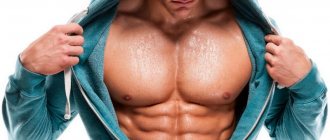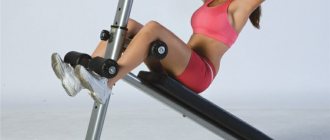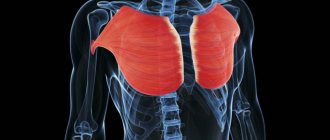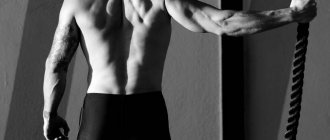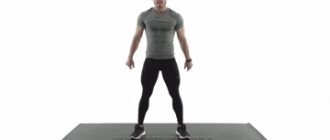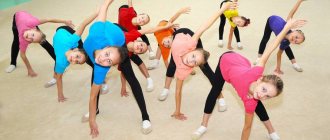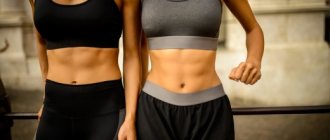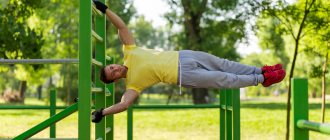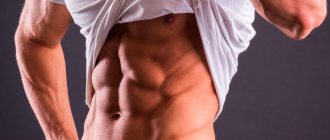September 28, 2012
We offer a series of exercises for the rectus, oblique and transverse abdominal muscles, as well as for the muscles of the lower back.
Modern people use their abdominal muscles infrequently, especially if they lead a sedentary lifestyle. However, a toned stomach is still considered a sign of sexuality and an indicator of good physical shape. We offer seven simple exercises for training the rectus, oblique and transverse abdominal muscles, as well as the muscles of the lower back, which are responsible for shaping the waistline. Don't forget that these exercises - like any other - are powerless against fat deposits around the waist, but they will help strengthen your muscles and make you look slimmer
.
How to do it right
Decided to do fitness at home? Find out how to pump up your abs correctly.
Exercise one
Place a stability ball under your lower back. Join your hands behind your head, spread your elbows to the sides. Place your feet on the floor with your knees bent at right angles. Try to lean forward towards your knees while maintaining balance on the exercise ball. Then return to the starting position.
Side bends
Bend-overs are also familiar to us from school, and despite the simplicity of the exercise, they are quite effective in working the internal and external oblique abdominal muscles.
- IP – standing, feet shoulder-width apart;
- hands are gathered at the back of the head;
- Keeping your back straight, lean to the left until you feel a stretch and tension in the opposite side;
- alternate tilting to the right and left.
Repeat the bends as many times as necessary. Optimal for beginners will be 10 times, 2-3 approaches.
This exercise can be complicated - lower your arms along the body, and take a dumbbell in one hand.
The difference from regular bends is that when bending to the right with a dumbbell in your right hand, you slide it along your leg, and your left hand is at your side or behind your head.
Bends also include the “mill”, familiar from school, when leaning to the left, with your right hand you reach for your left leg.
Exercise three
Kneel in front of the fitball and place the palms of your hands parallel to each other on it. Without lifting your feet off the floor, roll the fitball from your hands to your elbows. Try to keep your back straight - do not arch or strain it. Return to the starting position.
Oblique muscles
The oblique muscles have one peculiarity - they practically do not strain in everyday life, and do not always work in other exercises. Therefore, they need to be given special attention.
Only girls should treat their training with special caution.
The fact is that if you overdo it, you can get a straight, male-type body instead of a beautiful, toned waistline.
Exercise five
Lie on your back and lift your legs vertically up.
Place your hands behind your head and clasp them under the back of your head. Raise your shoulder blades off the floor, trying to reach your chin towards your knees. Return to the starting position. Don't believe the myths!
Are there any diets to reduce belly fat? How effective are squats and abdominal exercises against such deposits? We talk about myths and facts.
Abdominal muscle work
The abdominal muscles are involved in body movements: bending forward, turning and bending to the sides. When they contract, they pull the ribs down, reducing the size of the chest cavity, and thus participate in exhalation. Thanks to the tone, the abdominal muscles narrow the abdominal cavity and put pressure on the insides contained in it, that is, they play the role of a kind of supporting belt. This abdominal pressure is necessary when straining during bowel movements, urination, coughing and vomiting, and during childbirth. The diaphragm takes part in these processes (contracting during inhalation, it presses on the abdominal viscera from above) and the muscles of the perineum, which create support from below.
Strong physical activity helps maintain optimal tone of the abdominal muscles.
Exercise seven
Lie on your back, bend your knees at right angles, and place your heels on the floor. Place your hands behind your head and clasp them together. Raise your shoulder blades without changing the position of your legs. Hold your body in this position for about ten seconds, slightly lifting your buttocks off the floor. Return to the starting position. Photo: AlexGroundwater
Tags:
- Back
- Stomach
- Exercises
To leave a comment you must be an authorized user
Abdominal muscle structure
Despite the large area of the group, the abdominal muscles consist of 4 parts. Anatomically, the abdominal muscles are divided into outer and inner layers.
External:
- Rectus muscle;
- Oblique abdominal muscle;
Deep abdominal muscles:
- Internal oblique abdominal muscle;
- Transverse muscle.
Abdominal muscles: anatomy picture-diagram
When it comes to training, it is important to take into account the structure of the abdominal muscles. Otherwise, it will be difficult to ensure correct and effective load on each individual area.
Rectus abdominis muscle
The rectus abdominis muscle is anatomically considered the largest in the group. If you evaluate the general table of abdominal muscles, it is this that has the highest priority in fitness. Starts from:
- xiphoid process;
- From the outer surface of the costal cartilages V-VII (three teeth).
Attached to the pubic ridge.
External oblique muscle
The external oblique abdominal muscle starts from the outer surface of the V-XII ribs (8 teeth). Attaches to:
- External lip of the iliac crest;
- Pubic tubercle and ridge;
- Linea alba;
- Inguinal ligament.
Internal braid muscle
The internal oblique originates from the iliac crest, inguinal ligament and thoracolumbar fascia of the abdominal muscle. Attaches to:
- Cartilage of the IX-XII ribs;
- Pubic ridge.
Transverse abdominis muscle
The transverse muscle begins from the cartilages of the VI-XII ribs and the costal processes of the lumbar vertebrae. Attached to the white line. As a rule, there is no need to train the internal abdominal muscles in fitness; they receive enough load when performing regular exercises.
Functions of the abdominal muscles
Functions of the abdominal muscles
Each muscle has its own immediate tasks, but there are also general functions of the abdominal muscles.
- When fixing the pelvic area with the help of muscles, the torso can tilt in all directions.
- If you fix the upper body, thanks to the muscle corset you can lift and bend your legs.
- They are antagonists of the trunk rectifiers and influence the state of posture.
- When fixing the spine and pelvis, the chest is pulled back, which allows you to inhale and exhale.
- Thanks to them, the abdominal organs are kept in the correct position.
- Helps increase active muscle strength, which comes from the pelvis to the lower extremities.
The abdominal muscles perform a protective function, as they protect internal organs and systems from injury, shock, etc.
Anatomy of the abdominal muscles, their location on the abs.
In this article I will describe and clearly show the location of the abdominal muscles. This information will be useful to everyone who plays sports and wants to build beautiful abs . After all, in order to pump up any muscles, you need to understand what kind of muscles they are, what they do and how, in order to understand exactly how to work with them.
I’ll say right away that men’s abs are no different from women’s. But each person has a different structure of the abdominal muscles , the types of muscle groups are of course the same, that is, everyone has the same set of these groups. But the shape and even the number of abs cubes may differ.
Each person has his own peculiarity of the anatomical structure of the abdominal press. There's nothing you can do if you wanted a perfectly painted grid of cubes, but you have lopsided or even twisted cubes. We must accept them as they are. You can only influence the size and drawing.
The functional purpose of the abdominal muscles , that is, the press, is the same for all people. The abdominal muscles form the abdominal wall, protect and support the internal organs, participate in maintaining the spine and form posture. These muscles are hardy, which leaves its mark on the characteristics of their training. Abdominal muscles require a high number of repetitions during exercise.
The structure of the abdominal muscles, that is, the press, is described below.
1. Rectus abdominis muscle.
It is a long muscle of the anterior wall of the abdominal cavity. It originates at the pubic crest and, heading towards the top of the abdomen, attaches to the ribs and sternum. Three or four transverse tendon bridges interrupt the muscle fibers and thus form the well-known “cubes” on the abdomen.
Function of the rectus abdominis muscle: bending the torso forward, pulling the ribs down; raises the pelvis with a fixed chest.
2. External oblique abdominal muscle.
It is the superficial and largest muscle of the abdomen; the fibers of this muscle run obliquely from top to bottom. The oblique abdominal muscle pulls the ribs down and flexes the torso, while simultaneously contracting the left and right muscles, raising the pelvis with a strengthened chest. Rotates the torso in the opposite direction with unilateral contraction.
3. Internal oblique abdominal muscle.
This muscle makes up the second layer of the abdominal wall and is located under the external oblique muscle of the abdomen. The muscle fibers are located obliquely from bottom to top. The internal oblique muscles of the abdomen are responsible for flexion of the torso, contracting on both sides, and they also raise the pelvis with a fixed chest. They also rotate the body in their direction during a unilateral contraction.
4. Transverse abdominis muscle.
Forms the third layer of abdominal wall muscles, which is the deepest. The muscle bundles, passing from back to front, are located horizontally and go around the waist. The transverse abdominis muscle reduces the size of the abdominal cavity during contraction, while tightening the abdomen and pulling the ribs towards the midline.
This set of muscles forms the abdominals. By working together, the abdominal muscles bend the torso to the sides and forward, and are also responsible for turning to the sides around the longitudinal axis.
You will be interested in learning effective abdominal exercises.
Read further:
Guide: how to pump up six-pack abs at home quickly and effectively
How to pump up ripped abs
21 exercises for the abdominal and back muscles with your own weight
Pumping up your back muscles: a guide for beginners on how to make your back wide and sculpted
How to pump up your pectoral muscles at home
Rate this article:
(1 ratings, average: 5.00 out of 5)
Share with friends on social networks:
Tips for perfect abs
The diet should be varied, with a predominance of protein foods.
To prevent fat deposits from being deposited and the stomach to be sculpted, special attention must be paid not only to the technical performance of physical exercises, but also to nutrition. The diet is enriched with products that accelerate the fat burning process. Advice from experienced trainers:
- Protein is the basis of the daily diet. If the diet is enriched with this particular “building” element, fat is quickly burned and muscle mass increases.
- Fats should prevail in the diet over carbohydrates. Processed and refined carbohydrates have a particularly detrimental effect on muscle fibers.
- It is important to enrich your diet with fiber. It is found in large quantities in vegetables and fruits, whole grain bread and cereals. The advantage of these products is that they are low in calories, but at the same time saturate the body for a long time.
- Regularly eat yogurt, which saturates the gastrointestinal tract with beneficial bifidobacteria.
The importance of drinking plenty of fluids and not fasting should be remembered. Small but frequent meals speed up metabolism and fats are eliminated from the body.
